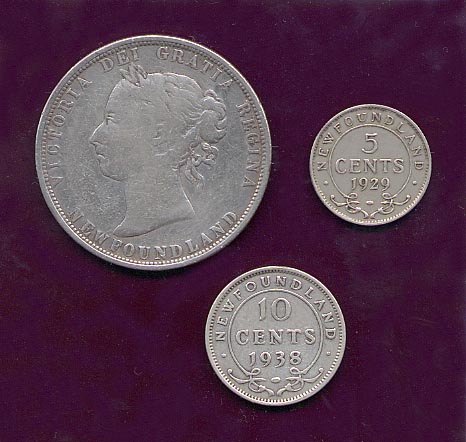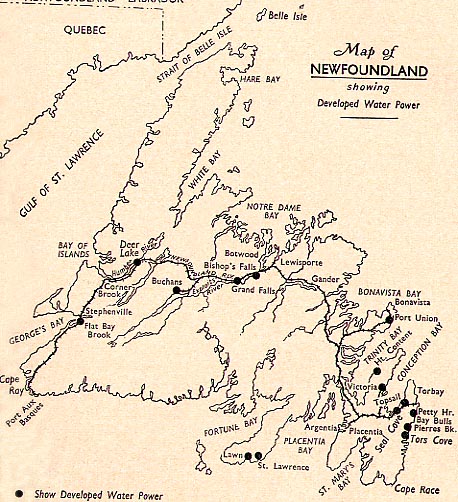
History

 |
Newfoundland History |
 |
Economic History of Newfoundland
This text was written in 1949. For the full citation, see the end of the document.Text between brackets [...], images and links have been added by Claude Bélanger.]
The economic fortunes of Newfoundland have always been vitally linked to those of the cod fisheries. An almost complete dependence on cod as her one staple export was the source of most of the instability which characterized her economy up to and through World War I. For three centuries after discovery, Newfoundland remained little more than an anchorage for European fishing boats, since settlement and the development of political institutions were discouraged by the fishing interests. The eventual growth of political institutions in the early nineteenth century reflected the colony's gradual release from the domination of these interests and the beginnings of efforts to diversify her economic bases. The 1920's, however, saw the first concerted efforts at diversification, and this was achieved only through the incurrence of a heavy foreign debt which had very serious consequences both political and economic. Diversification, moreover, consisted in development of new export staples just as sensitive to world economic fluctuations as cod had been. Thus, although some flexibility was introduced, the economy remained completely dependent on world markets and subject to all the fluctuations incidental to such dependence.
The influence of mercantilism was important in shaping the patterns of the early fisheries. Although the Portuguese, Spanish, and French were among the first to use the island as a base for fishing, they were gradually displaced by the more aggressive fishermen from the west of England who began visiting the island in force after 1550. Lack of solar salt forced the English to use the beaches along the coast to dry their catches before exporting them; this practice was the principal reason for the west country's opposition to settlement. With the defeat of the Spanish armada, the position of the west country interests was strengthened and pressure began to be exerted to obtain the support of parliament in preventing settlement. In these endeavours, the private interests of the west country fishermen coincided with those of mercantilistic England : exploitation of the fisheries was regarded by England as an ideal method of extracting new-world specie from Catholic Spain, as well as a method of training seamen. Thus the claims of the powerful west country group gained sympathy in parliament in the seventeenth century and found expression in a series of edicts designed to discourage settlement on the island as much as possible.
The English colonizers were forced to turn their attention to the mainland, particularly to New England , where settlement grew rapidly in the early seventeenth century. The productivity and aggressiveness of the New Englanders meant that patterns of trade began to emerge which had a significant influence on Newfoundland 's development. New England found ready markets in the West Indies for her agricultural produce, in exchange for sugar and rum; Newfoundland came to be regarded as a good source of English bills of exchange and the New Englanders pressed for increased settlement of the island, in the hope of increased trade. Thus in the New Englanders, the west country interests met their first real opposition.
Passage of the Navigation Acts in 1650 stimulated activity in the carrying trade and weakened the fisheries. The French, encouraged by this weakening of the English fisheries, built Placentia on the south-east coast of Newfoundland in 1662. Although Placentia was never able to achieve a strong position, because of the lack of concentration of the French effort in the fisheries, it has been estimated that three quarters of the Newfoundland coast was in French possession in 1701, and the island had become a significant marketing centre for goods moving in contravention of the Navigation and Warehousing Acts. With the Treaty of Utrecht in 1713, the French moved out of Newfoundland and replaced Placentia with Louisburg on Cape Breton . They retained, however, valuable fishing privileges between Cape Bonavista and Point Riche, privileges which were restated in later treaties in 1763 and 1783. The west country interests steadily lost ground after 1713 because of continued pressure from the New England traders, and toward mid-century were forced into the bank fishery because of the growth of settlement along the coast.
The initial growth of settlement, however, brought many ills to the colony. The better grades of labour were readily attracted to New England , while the poorer grades remained to be exploited by the rapidly-growing merchant class in the island. Exploitation was rife under the "truck system" whereby the merchants outfitted the fishermen in the spring and collected when the catch was in [ Note from the editor : in the "truck system" the fisherman was supplied by a merchant the yearly provisions and gear he needed to fish and support his family against the guarantee of his future catch. In such a system, the fisherman was always in debt, was not free to take his catch to the highest bidder and rarely saw any cash. It was virtually a form of bondage guaranteed to keep him permanently indebted and in poverty.]; and the constant flow of rum from New England did little to improve the material condition of the exploitees during the long winter months. Still, settlement continued to grow and by 1804 the population of the island numbered close to 20,000.
Under these circumstances, there arose a demand for governmental institutions, so far denied as a result of west country pressure. The demand gained impetus during the period of prosperity which accompanied the war of 1812-14, and culminated in the granting of a representative assembly in 1832. Between 1832 and the granting of responsible government in 1854, some advances were made toward Newfoundland 's becoming a commercial and economic entity. The seal fishery took on new life after 1830, helping to absorb ships and men in the off-season of the cod fishery, and giving rise to a shipbuilding industry around St. John's . Agricultural acreage increased from 11,062 (1836) to 41,168 (1855), although the industry remained completely subordinate to fishing. The first banks were incorporated in the island during these years. Steam connections with Halifax were opened up in 1854. All in all, it can be said that responsible government was a reflection of the progress which Newfoundland had made toward economic maturity.
When, in the early 1860's, federation of the provinces of British North America became a definite prospect, Newfoundland showed considerable interest, and even sent two representatives to the Quebec conference in 1864. Ultimately, however, both economic and political factors conspired to keep her out of the federation. Unlike the provinces of British North America , Newfoundland had no heavy debt, no pressing railway problem, no immediate fear of United States hostility. Nor could she hold out much hope of broadening her markets through federation; indeed, in her only important export, codfish, she was in direct competition with Nova Scotia . Consequently, by 1869, the whole question was shelved and was not reopened until the mid-1890's.
The intervening period was one of general prosperity for the island, characterized by the further broadening of the bases of economic activity. Advances were made in farming and mining. A transinsular railway line was completed in a large semi-circle connecting St. John's with Port aux Basques in 1896. As was the case in Canada , construction was slow and uncertain and was only brought to completion by substantial government subsidies and land grants. The building of the railway generated considerable subsidiary activity, and numerous smaller types of enterprise sprang up, most of them locally managed and financed.
The disastrous bank failure of 1895, however, put an end to the period of prosperity and foreshadowed the chronic difficulties which have beset Newfoundland 's economy ever since. The immediate crisis was precipitated by the return of the bills drawn on an English firm, one of whose members had died. A deeper reason, however, lay in the inherent instability of Newfoundland 's economy, stemming from her too great dependence on the fishing industry. On December 10, 1894, the Union and Commercial Banks, both local enterprises incorporated in 1854 and 1857 respectively, were forced to close their doors. Since the Union Bank was the financial agent of the government, its failure was a serious blow to the public credit. Unable to meet interest charges on the public debt, the government turned first to Britain, then to Canada , for assistance. Britain, however, would do nothing without first appointing a royal commission, and this Newfoundland refused, largely through fear of losing her responsible government. Negotiations with Canada, conducted at the Ottawa conference of 1895, were equally unsuccessful, Newfoundland 's renewed interest in federation being thwarted by disagreements on financial grounds. Failure of these efforts rendered the island's credit position even more precarious, and only the forthright action of Robert Bond, the colonial secretary, in raising loans on private money markets in London saved the country from financial chaos. Two Canadian banks, the Bank of Montreal and the Bank of Nova Scotia, opened branches in St. John's in 1895, and established the Newfoundland currency on the basis of the Canadian dollar.

Examples of Newfoundland silver coins: the 50¢ was issued in 1882,
the 5¢ was minted at the beginning of the Great Depression and
the 10¢ in 1938. For a history of Newfoundland's banking institutions and currency
consult this page.
World War I brought a period of prosperity to Newfoundland , mainly because of the prosperous condition of the fishing industry. Prices were high and the demand was steady. Overoptimism and over-expansion characterized economic activity, however, and the cultivation of land fell off. The result was an inflationary period immediately following the war, followed by a depression in the early twenties. The chronically unprofitable railway had to be taken over by the government in 1923, along with steamship and telegraph services. The rise of economic nationalism in many European countries brought renewed hardships to the fishing industry and emphasized once again the necessity of greater diversification in the country's economy. Increased competition was encountered from Norway, Iceland, Spain and Italy. Iron-ore mining on Bell island, begun in 1895, slackened during this period in response to a decline in the Nova Scotia steel industry.
The twenties saw new efforts at diversification. An extensive highway program was undertaken in 1924; the Corner Brook paper mill was completed in 1925; the output of mines, forests, and agriculture were generally increased. But such efforts were now pursued only at the cost of heavy capital imports and foreign borrowing. Government provision of public utilities to support industrial diversification, combined with her railway deficits and the costs of post-war demobilization, doubled the public debt between 1920 and 1930. Although diversification had lessened the country's dependence on the fishing industry, she remained as dependent as ever on foreign markets, and demand for her products was still extremely sensitive to world economic conditions. In general, servicing of the debt during this period had to be financed by further borrowing abroad.
The depression of 1929 struck Newfoundland with cruel severity. A sudden shrinkage of exports, combined with increasing demands on the public treasury, brought the country to the brink of ruin. Wages fell drastically; unemployment was increased by the disappearance of opportunities for seasonal employment outside the country, and relief expenditures rose to unprecedented heights. Deficits, piled up until in 1933 the national debt was over $100 millions, 95 per cent of it held outside the country, particularly in the United Kingdom . Finally, in 1933, a royal commission was appointed at Newfoundland's request, to report on the situation. As a result of this investigation, Newfoundland relinquished responsible government and placed itself under a commission government in 1934.
World War II did much to improve Newfoundland's credit position. American and Canadian defence expenditures were an important factor in reducing the total debt from $101 millions in 1931 to $88 millions in 1945. In addition, the average interest rate had fallen from 5 to 3 per cent. But these favorable factors should not obscure the fact that Newfoundland's peacetime debt position since 1920 has been one of persistent deficit and the future holds no definite prospect that the situation will be changed. The inexorable facts of meager natural resources, low productivity and consequent low taxable capacity, have still to be taken into account in any attempt to estimate future government debt.
The progress of diversification of industry brought the pulp-and-paper industry into position as the foremost contributor to national income in the late thirties, although the fishing industry still provides livelihood for the largest number of people. Mining holds third place in producing national income. Agriculture and manufacturing are still geared to the local markets. Exports are still the basis of the country's livelihood, and a stable, multilateral world trading system is thus of prime importance.

Since this text was written in 1949, it does not discuss a great resource of Newfoundland that is drawn
from the Labrador region: hydro-electricity. Picture above is Churchill Falls.
Over a 32 km distance, the river level falls more than 300m with a drop
of over 75m at the falls themselves. In the 1970's, the river was
harnessed and since 1974 it has been producing vast amounts of power that is
directed toward Montreal and the United States. Churchill Fallshas a generating capacity
of over 5,225,00 kw, one of the largest in the world. The contract signed with Hydro-Québec
has been the subject of much debate between Newfoundland and Quebec. This
debate is an extension of the Quebec-Labrador boundary dispute.
[See the Churchill Falls Corporation Limited (Lease) Act, 1961,
Hydro-Québec v. Churchill Falls, 1988, and the speech of Brian Tobin,
Premier of Newfoundland, explaining the position of his province in 1996]

Newfoundland map of the early 1950's showing the
hydro-power plant developments.
For recent statistics, see the Census of Newfoundland , 1945, and numbers of Foreign Trade, published by the Canadian department of trade and commerce. For an extensive bibliography of the subject, see the appendix to R. A. MacKay (ed.), Newfoundland : economic, diplomatic, and strategic studies (Toronto, 1946).
Source: W. Stewart WALLACE, ed., The Encyclopedia of Canada. Newfoundland Supplement, Toronto, University Associates of Canada, 1949, 104p., pp. 23-26. Some minor mistakes have been corrected. The text has been reformatted for the web edition.
© 2004 Claude Bélanger, Marianopolis College |